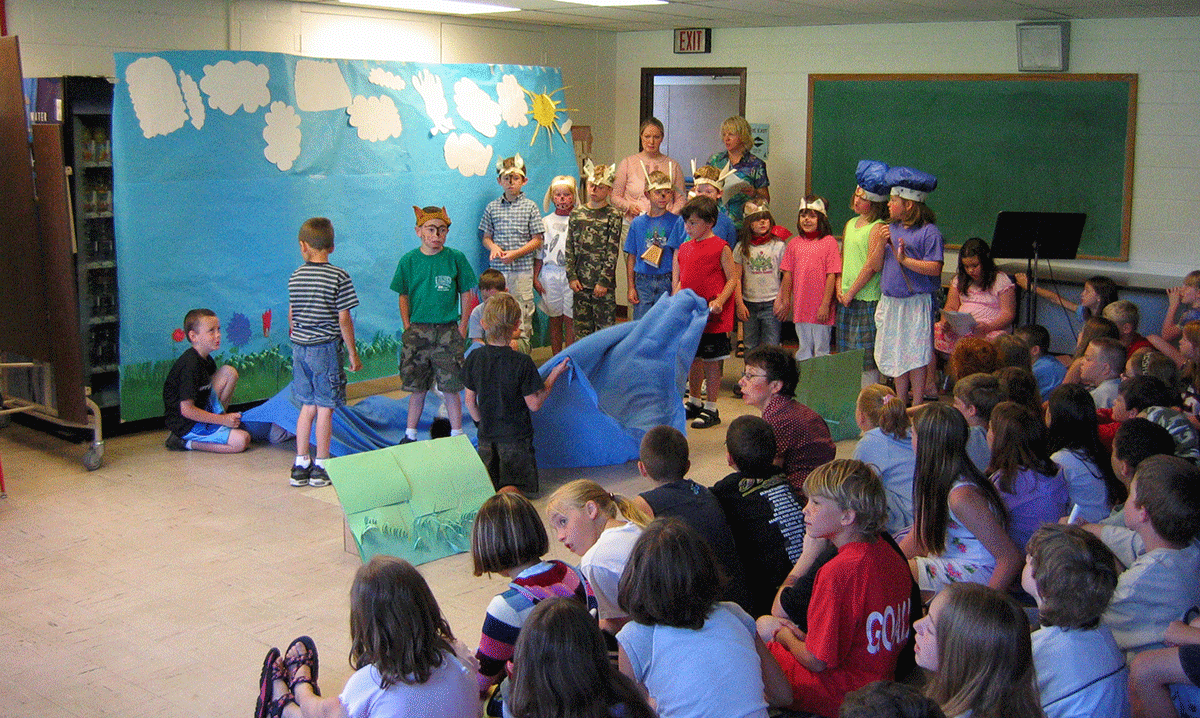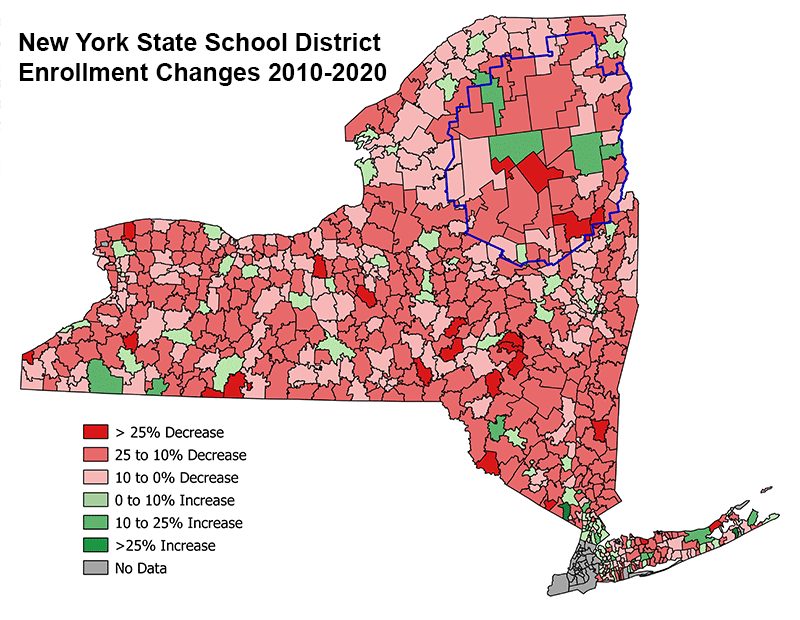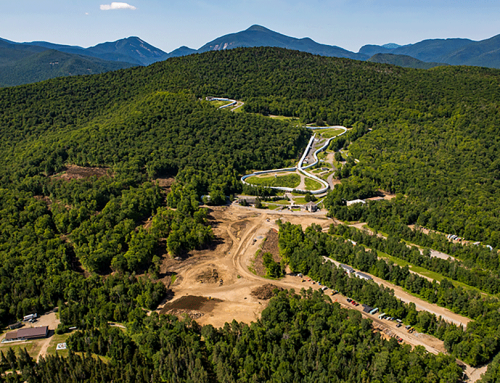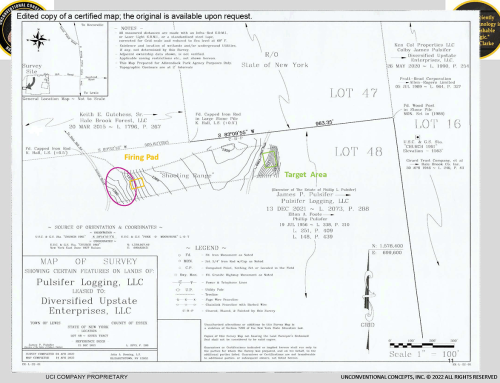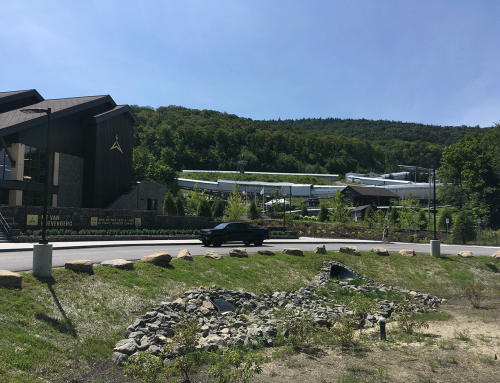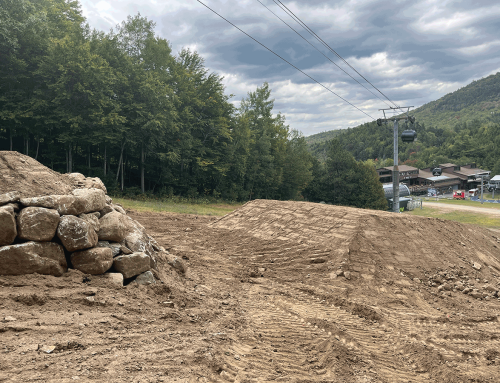It’s back to school time in the Adirondacks and New York State. One of the things that always happens at this time is reports about school district enrollments year-over-year in a particular area. These stories are useful and interesting, but they usually lack context.
With the beginning of the release of 2020 US Census data in August, Protect the Adirondacks is starting an update of its study The Adirondack Park and Rural America: Economic and Population Trends 1970-2010. The 2020 US Census will enable us to look at a 50-year trend line.
For school district enrollment numbers, these data are provided by the NYS Department of Education, but new Census data helps to provide context. In looking at the numbers for the school years 2010-11 to 2019-2020 from State Ed, we see that in the last decade, New York State public schools saw a drop of over 126,000 school children in all districts for which there was data. This does not include New York City.
In the last decade, New York’s secondary school enrollment, from kindergarten to 12th Grade, went from 1,697,244 in the 2010-11 school year to 1,570,736 in 2019-20, a loss of 126,508 students across the state, a 7% drop. In New York City, the total enrolled student population increased by over 3,000 students in the decade, increasing from 987,459 to 991,085. The state’s data does not include private and religious school enrollments, which in New York are sizable.
Across New York State outside of New York City, 106 school districts either experienced gains in student enrollments or were flat, while 563 school districts experienced declining enrollments from 2010 to 2020. In addition, there were 16 mostly small new districts in 2020 for which there was no data in 2010. Across New York, 82% of school districts experienced student enrollment declines from 2010 to 2020.
Westchester County saw strong growth, led by a 5% increase in Yonkers. On Long Island, Suffolk County saw some big school districts like Riverhead, Central Islip, and Brentwood, all post major gains. In Nassau County, a number of districts saw gains.
Across Upstate, there was growth in places like Lyncourt (+30%) in Onondaga County, Liberty (+15%) in Sullivan County, Wynantskill (+19%) in Rensselaer County, Portville (+14%) and Randolph (+13%) in Cattaraugus County, Dunkirk (+6%) in Chautauqua County, and Utica (+6%) recorded solid growth. All told, 258 school districts in New York State experienced drops of -10% to -19.9%, and 81 school districts saw drops of -20% or greater.
In the Adirondacks and North Country, the Clinton County districts all lost, with Plattsburgh and Beekmantown basically remaining flat. In Essex County, Schroon Lake and Crown Point saw slight gains, while Keene (down just 2 kids) and Moriah (-4%) saw minor losses. Lake Placid, Willsboro, Boquet Valley, Newcomb, and Minerva districts saw double digit losses.
In Franklin County, all the districts were down. Saranac Lake dropped by -14%, while Tupper Lake dropped by -12%. St. Regis Falls dropped by -10%, while the districts in Malone and the northern part of the county all dropped by single digits.
In Hamilton County, Long Lake saw a 12% rise, but that was from an increase of just seven kids, while all others lost. The new 2020 US Census had Hamilton County gaining 271 residents, but its four school districts of Long Lake, Indian Lake/Raquette Lake, Lake Pleasant/Piseco and Wells, (Inlet sends its kids to Webb) saw a combined net loss of 83 students in the decade.
In St. Lawrence County, Colton-Pierrepont, Herman-Dekalb, Norwood-Norfolk all showed slight gains, while bigger districts like Canton, Potsdam, and Massena posted single-digit losses. For the most part Lewis County schools held their own, seeing minor losses. Oneida County saw their rural schools drop, while the City of Utica school district grew.
In Fulton County, Broadalbin-Perth saw a minor loss, while Gloversville and Johnstown dropped by double digits. In Saratoga County the huge districts like Shenendehowa, Saratoga Springs, and Ballston Spa were flat or saw minor losses while the more rural areas saw drops. All told, Saratoga County experienced a net loss of over 2,300 students during a decade when the county gained almost 16,000 new residents.
In Warren County, the City of Glens Falls school district saw a single digit drop, as did North Warren. Johnsburg, Bolton, and Queensbury dropped from -12% to -18%, while Lake George, Warrensburg, and Hadley-Luzerne all saw decreases over -20%. In Washington County, the Hudson Falls school district grew, while all other districts were down.
The first cut of the 2020 US Census data provides information primarily for state officials to redraw state and Congressional election district lines. The Census data did not include complete age-range information but did provide data about the number of people in a state’s population who were 18 years old or older and those younger than 18. From this data, we saw that 25 of the 50 states in the U.S. experienced a decrease of young people under the age of 18 years old in their population, including every state in Northeast U.S.
New York State saw a -4.9% drop in the number of young people under 18 years old from 2010 to 2020, some 211,815 fewer kids. This means that during a decade in which New York’s total population increased by over 825,000, the population 18 years old or older grew by over 1 million, while the population of people under 18 years old shrank by over 200,000.
This trend in New York played out the same in all the neighboring Northeast states. New Jersey experienced a -2.8% drop (-57,530) in young people under 18 years old, and Massachusetts was at -3.7% (-52,729). Pennsylvania saw a -5.1% drop (-143,003), Rhode Island saw a -6.3% drop (-14,171), Maine saw a -8.1% drop (-22,259), Vermont saw a -8.2% (-10,638) loss, and Connecticut saw a -9.8% (-80,298) loss. New Hampshire led the country with the biggest percentage drop in its number of young people under 18 years old with a -10.6% (-30,385) loss. This collective loss of over 622,000 young people throughout the Northeast U.S. occurred in a decade in which these nine states saw a population growth of almost 2.3 million.
That’s right, these nine states in the Northeast USA grew by over 2.3 million total residents from 2010 to 2020, yet at the end of the decade, there were over 622,000 fewer kids under the age of 18 years old. America is growing older and young people are having smaller families.
The data about the loss of young people is even more compelling when we look at racial trends. For instance, while New York State saw a net loss of 211,815 young people under 18, the number of such kids who were Asian American increased by over 78,000. The number of other race/multi-race kids grew by over 136,000 and Latino or Hispanic kids grew by almost 50,000. Conversely, the number Black kids in New York dropped by almost 106,000, and the number of white kids dropped by over 368,000. This trend has a particular resonance in the Adirondacks and North Country, where our school population is made up overwhelmingly of white kids from among an overwhelmingly white population, and the people who choose to move here have historically been overwhelmingly white people.
For those in the Adirondacks who are in the population recruitment business, the recruitment of young white people and white families into the Adirondacks isn’t going to help much with our school enrollment numbers and trends.
What’s happening in New York is all part of larger national trends. While there are just over 1 million fewer young people across the country under the age of 18 years old in 2020 as compared with 2010, there are over 5.1 million fewer white kids in real numbers and over 687,000 fewer Black kids, while the population of Asian American, Hispanic or Latino, other race, and multi-race children all grew significantly.
The forces and trends shaping Adirondack Park school district enrollment numbers are the same forces and trends at play across Rural America. There is nothing unique happening in the Adirondack Park. As much as local political and community leaders like to blame the Park or the Forest Preserve or environmental groups for the challenges facing Adirondack communities, the story that is playing our here is the same story that is playing out in thousands of small towns and school districts across Rural America. The initial 2020 US Census data showed us that 53% of all counties in the U.S. saw a population loss from 2010 to 2020.
The challenges facing Adirondack communities should be seen as part of a series of larger trends facing Rural America and not something driven by particular state policies. The Adirondack Park has long suffered from a misdiagnosis of the causes of our population/school enrollment and economic challenges, which has led many to chase false solutions.
This article was also published at New York Almanack.
This article was also published at Adirondack Almanack.

